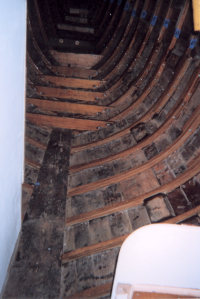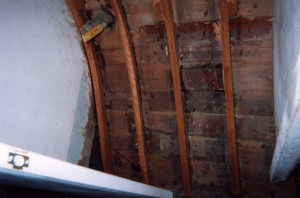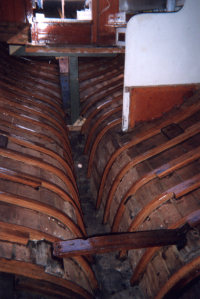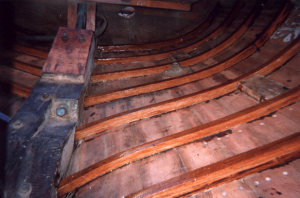July 2001
Page 6
A note about penetrating epoxy and our plans at this point:
Earlier we had decided to epoxy in splines to the plank seams. After a
conversation with Steve Smith (the inventor of SMITH'S penetrating
epoxy) we changed our minds. Steve tells us that penetrating epoxy is
"hydro-phobic" but not hydro-proof. This means that water stays out of
the wood but the penetrated epoxy treated wood does absorb water vapor.
Accordingly, the planks will eventually swell up and become just as
water laden as un treated wood. Because one of the purposes of a seam
is to absorb the flexing and swelling of the planks as they take on
water (vapor) and move while under way (as in sailing... which is what
this is all about) we decided not to have the seams become rock solid by
gluing in splines. Our fear is that the planks themselves would become
the brunt of these flexing and swelling forces. So, the decision now
stands at using the 3M product, 5200, as the only seam compound. Our
worry in this decision is the elimination of the structural integrity
which the cotton gives the overall hull structure. Steve Smith
indicated to us that the molecular structure of the 5200 is such that it
will provide this force locking the planks against each other.
Page 1 | Page 2 | Page 3 | Page 4 | Page 5 | Page 6 | Page 7| Page 8

Once the ribs have been fully penetrated with SMITH'S they receive a final coat of epoxy resin to seal everything in. This step took 1
person about 7 hours
The sealing of the ribs protects the wood and staples used in the laminating process. The final product also looks great.


Here's the head again after the finish epoxy coat has been applied.
Did we already say that it looks great?? Yeah, I thought so. This view is from the head toward the stern.


The engine compartment after the ribs have been epoxied. Note how
the planks look here. During the surface grinding of the ribs Doug
touched up each plank with the coarse grit paper. This removed the
de-lignifiedwood fibers. Prior to laying down each rib the same process
was followed. The resulting "fresh" surface of the planks on the
interior will be penetrated with a "sauce" of linseed oil and
turpentine.to return some moisture to the wood.
In the meantime we were finishing off the reefing out of the seams at the keel.
